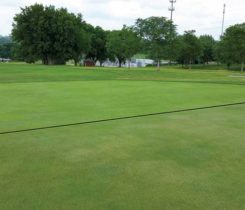Dollar spot control 2014: New fungicides and modern approaches
It is sometimes difficult to imagine that more than 80 years after dollar spot was first described, this disease commands so much attention from superintendents, academics and the turf industry in general. The causal agent (currently Sclerotinia homoeocarpa) is an unpretentious fungal pathogen. Infection occurs by direct penetration of mycelium into plant tissues with no spores (at least none observed by scientists in the U.S.) to complicate the disease cycle. The present consensus is that S. homoeocarpa survives in infected and infested plant tissues.
The dollar spot problem
Dollar spot is the first turf disease that students learn to identify because the unmistakable signs and symptoms (Figures 1, 2 and 3) are described in great detail. The environmental conditions (temperature, moisture, plant nutrition) that promote infection and disease development are well documented and familiar to most turf managers. Since 1990, researchers have published twice as many papers and reports on dollar spot than the next most popular disease topic, Rhizoctonia blight, and more than all root diseases combined. I think it is fair to say that we know as much about dollar spot as any turf disease. It is the common cold of turf diseases, easy to identify, affecting almost all species and without a cure.
And yet, more money is spent on fungicides to control dollar spot than any other infectious disorder of turf. New products were recently added to the fungicide arsenal. Although there are no magic bullets, the new compounds improve our ability to execute sound strategies to limit the threat of dollar spot outbreaks. Before we fully engage the 2014 season, it would be prudent to review our approach to dollar spot control, while paying special attention to fungicide selection and application timing.
Disease management involves integrating four categories of control options: genetic, cultural, biological and chemical. Although we turf pathologists often preach utilizing non-chemical options before chemical control, in this narrative I address fungicides first. That’s because at any site where dollar spot becomes problematic, fungicides remain the only stand-alone option to reduce damage to tolerable levels and maintain high quality playing surfaces. Furthermore, the non-chemical options serve only to reduce disease pressure and we know that fungicides will be more effective and efficient when disease pressure is reduced.
The Modern Fungicide Arsenal
Until recently, the foundation of dollar spot control was based on a contingent of four effective fungicides or fungicide classes including chlorothalonil, thiophanate-methyl, DMI compounds (metconazole, myclobutanil, propiconazole, tebuconazole, triadimefon, triticonazole, difenoconazole) and dicarboximides (iprodione, vinclozolin).
The contact fungicide chlorothalonil remains an important part of any program because of its broad spectrum of activity. It is effective against many diseases, including dollar spot and its multi-site nature. The multi-site feature is essential in anti-resistance strategies because the likelihood of a pathogen population evolving a resistance to a multi-site compound is zero or near zero. It kills fungal cells without the risk of selecting for resistant individuals.
However, there are government-imposed limits to the amount of chlorothalonil we can apply and these restrictions complicate the task of controlling disease on fairways. Successful superintendents rely on their understanding of fungicide strengths and deficiencies to schedule chlorothalonil sprays at the most opportune times to get the most out of each application.
The new fungicide fluazinam (Secure, Syngenta) will be especially helpful where fairway outbreaks are a serious concern. Fluazinam is actually an old fungicide that was only recently introduced to the turf market. It is also a contact material and is advertised as a multi-site compound. Fluazinam’s forte is in dollar spot control and it should be used judiciously to relieve some of the burden from chlorothalonil. In reality, it is not multi-site to the same degree as chlorothalonil. Fluazinam has a FRAC code of “29” as opposed to chlorothalonil’s FRAC code of “M.” There is suspected resistance to a Botrytis (related to Sclerotinia) pathogen of crops in Japan. The point in making the distinction is that we should be careful not to “over-use” fluazinam and tempt fate with the evolution of fungicide resistance.
Other fungicides for dollar spot control are classified as penetrants. Active ingredients diffuse into leaves and stop or limit pathogen growth inside turf plants — that’s the main reason why they tend to keep dollar spot outbreaks at bay for longer periods of time than contact fungicides.
Among the most widely recognized penetrants are the DMI compounds, the dicarboximides and thiophanate-methyl. They can be effective against many different turf pathogens, but are site-specific fungicides, like all penetrants, meaning that populations may evolve to the point where the majority of individuals become resistant to the active ingredient. This results in failure to control.
The newest active ingredients introduced into turf markets are in a class called SDHI (Succinate DeHydrogenase Inhibitors). It is likely that this class will be subdivided since active ingredients do not have the exact same mode of action, as in other classes, and from a practical perspective, includes compounds with widely varying efficacy.
Boscalid (Emerald) and flutolanil (Prostar) are in the SDHI class. Of course Prostar is not a new fungicide, nor is it the least bit effective against dollar spot. Emerald is both relatively new and primarily targeted to control dollar spot. New SDHI compounds include penthiopyrad (Velista, Syngenta) and fluxapyroxad (Xzemplar, BASF). All research reports to date support very good to excellent efficacy of these fungicides against dollar spot, but results are mixed with regard to control of other diseases.
Again, they are site-specific (FRAC Code 7) penetrant compounds and anti-resistance tactics should be considered when positioning SDHI applications in the season-long fungicide program.
Approaches to Utilizing Fungicides Effectively
Given these effective tools to stop pathogen growth and allow turf recovery to proceed, how has this simple pathogen morphed into such a relentless problem?
Consider that infection and colonization occur over a broad temperature range. Therefore dollar spot outbreaks are a threat for most of the growing season and superintendents must be constantly vigilant of conditions that promote infection. Depending on expectations, season-long protection against outbreaks is warranted. We have an impressive array of fungicides to do the job, but regulatory restrictions and the threat of fungicide resistance present a serious challenge to superintendents as they formulate an effective approach to dollar spot control.
The “program” approach is the de facto preventative approach. It is my opinion that this approach will result in the most effective and efficient use of our chemical assets for disease control. If you are skeptical, consider the tried-and-true axiom: an ounce of prevention is worth a pound of cure.
I understand the argument for the “curative” approach. We have very effective fungicides that stop pathogen growth in turf, they are “chemotherapeutic.” However, because pathogens are microscopic, with one dollar spot infection center containing tens of thousands of infectious cells and the infection process including an incubation period, there is so much more disease than meets the eye. As a result, the pathogen component of disease pressure is increased.
Over a given season, depending on the weather, more fungicide will be required for adequate control under conditions of high disease pressure than low disease pressure. There are countless reports of season-long efforts to “catch-up” after a dollar spot outbreak has occurred. Results are not always satisfactory and unless cool, dry weather lends a helping hand, it will always be more expensive than the preventative approach. This may also hasten the evolution of fungicide-resistant pathogen populations.
Non-chemical control options cannot stand alone in controlling dollar spot when weather conditions favor infection. However, they do serve to reduce disease pressure and therefore may be exploited to improve the efficacy and efficiency of any chemical control program.
Some modern creeping bentgrass cultivars (Declaration and others) possess a genetic resistance to infection. They are not immune to dollar spot, but compared to more susceptible creeping bentgrass cultivars (e.g., Penncross, Pennlinks, L-93), disease develops more slowly and infection centers are often smaller in size. As a result of the improved genetic resistance, less fungicide will be required to achieve acceptable levels of control than on the more susceptible cultivars.
Certain cultural practices such as maintaining turf with ample nitrogen nutrition, displacing morning dew by poling or mowing and implementing a lightweight rolling regimen also reduce disease pressure and contribute to optimal use of fungicides.
I think the benefit of most biological treatments for dollar spot control remains questionable. However, most research with mineral oil applications shows a reduction in dollar spot severity compared to untreated turf and suggests that control with conventional fungicides can be improved by including the mineral oil in a tank mix.
Some turf scientists have rediscovered the fungistatic nature of two plant growth regulators (PGR), flurprimidol (Cutless) and paclobutrazol (Trimmit). These compounds are related to DMI fungicides and will reduce disease severity. However, because of their chemical similarity to DMI compounds, they are likely to accelerate the rate at which pathogen populations evolve towards resistance to registered DMI fungicides. Fungicide resistance within dollar spot pathogen populations should be a consideration in any program that involves these two PGR compounds.
Because of the season-long dollar spot threat, most effective approaches involve repeated application of fungicides at regular intervals. Higher rates and shorter intervals will result in a reduced risk of serious dollar spot outbreaks. One of the more contemporary issues with regard to dollar spot control involves the timing of the initial application. There is the notion that early, first or second mowing applications of a certain fungicide will limit dollar spot development for months afterward.
Any explanation must be based on logic and the biology of the dollar spot pathogen rather than unsupported supposition. Given the nature of apical growth in fungi, the pathogen must be active (growing) for the fungicide to be effective. If environmental conditions favor pathogen growth and an effective compound is applied at that time, the fungus will acquire the fungicide. Once inside the mycelial threads, the fungicide disturbs cellular functions stopping pathogen growth, allows turf to recover and effectively controls the potential outbreak. For any geographic location, historical temperature averages define the dollar spot “window.” In most cases, the initial fungicide application scheduled at the beginning of the window is most effective.
So here we are at the beginning of the 2014 season, poised to do battle with this simple but stubborn pathogen. Our approach must be based on a sound disease control strategy that includes reducing disease pressure through implementation of sound cultural practices, understanding efficacy and limitation of fungicides registered for use against dollar spot, anticipating the initial outbreak and following a preventative rather than curative approach and positioning your dollar spot sprays with consideration of other diseases that threaten as the season progresses.
Rick Latin, Ph.D. is a professor in the Department of Plant Pathology at Purdue University specializing in turfgrass disease identification and control. Rick Latin, Ph.D. can be reached at rlatin@purdue.edu for more information.













